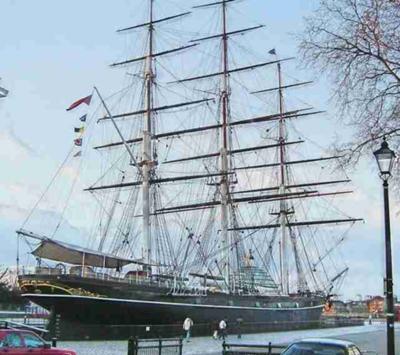The last real square-rigged ships in the 18th., 19th. and 20th. centuries.
by Han
(Brittany, France)

Cutty Sark.
At the second half of the 18th. century the hull of the sailing ship had been developed from the galleon to it's almost ultimate shape, at least below the waterline; above the upper deck the forecastle had almost gone, and during the 19th. century the half- and quarter-decks disappeared too.
As the hulls were, apart from their length and width, so much alike, they were named more and more after their rig, with the exception of the men-of-war. These were classified for their firing capacity; the smaller were the corvettes, then the frigates and the biggest ones were the third, second and first-rate ships of the line.
Their rigging did not differ much from the merchantmen.
See also:
http://www.hms-victory.com/ and: http://en.wikipedia.org/wiki/HMS_Victory.
As time advanced, so did the rigging: the gaff-mizzen and gaff-topsail, stay-sails and studding-sails (http://en.wikipedia.org/wiki/Studding_sail) were added, and the initially very big, two for each mast, square sails were devided up into smaller ones, up to six for each mast, for easier handling and smaller crews.
The pirates, buccaneers and privateers needed big crews on relatively small, fast ships. They used brigantines, brigs and snows: two-masted ships under a big cloud of sails, see:
http://en.wikipedia.org/wiki/Brigantine, and
http://en.wikipedia.org/wiki/Brig.
Their origin was trade, but the faster ones were often commandeered by the pirates.
One special trade also needed speed: the China-England tea trade. In 1845 the Rainbow was launched in New York as the first clipper, but apart from the Flying Cloud the American clippers were outclassed by the English tea-clippers Thermopylae and, of course, Cutty Sark, built in 1869 to out-sail Thermopylae, considered to be the fastest ship then. See also http://en.wikipedia.org/wiki/Clipper, and http://www.cuttysark.org.uk/index.cfm.
On the one occasion they started at the same time, Cutty Sark damaged her rudder but arrived in London only a week later than her rival; she had proved to be a serious contender, but failed to prove her superior speed.
The last square-riggers before mechanical propulsion took over were the barques: steel-built, with steel masts, spars and booms, of which the mizzen was rigged fore-and-aft, and the other masts square.
See: http://en.wikipedia.org/wiki/Barque. Almost all of them were built for a German ship-owner, who gave them all a name beginning with P. Because they were fast, the company was unofficially called the Flying P Line. A couple of them still sail as training-ship.
One of them has to be mentioned apart, because it wasn't a barque but a full-rigger, like the clippers (full-riggers are square-rigged on all masts). Her name was Preussen; launched in 1902 she had five masts which carried 47 sails with a sail area of 50,000 sq. feet. She was the only five-masted square-rigger in the world.

